Knives are your most important tools in the kitchen. This 3 part series on kitchen knives will help you make the best knife choice. The first thing well touch on are the major features of your typical kitchen knife so you know what to look for when selecting the right kitchen knife for you.
How knives are made: Stamped vs. Forged Blades
Stamped blades are cut from large, flattened sheets of steel just like cutting cookies from dough. Knives made with stamped blades are typically lighter and less expensive.
Forged blades are made by pouring heated steel into a mold, then successive heating and cooling tempers the blade for density and strength. Forged knives are typically stronger and heavier with a bolster for balance.
The weight difference between stamped and forged blades can amount to two ounces. This may be substantial to some people, inconsequential to others. I think the bigger difference is the bolster which I feel gives a knife a better balanced feeling in your hand.
The Tang: Full, Partial or Rat-Tail
The tang is part of the blade itself. It is the part where the handle attaches to the knife.
A full tang knife has the metal from the blade running fully into the handle giving the handle greater heft and producing a sturdier, well-balanced knife.
A partial tang knife does not have the blade metal running the full length of the knife handle. These knives will be less sturdy.
A rat-tail tang knife has a tang that is much thinner than the spine of the blade. The tang is typically heated and inserted into the handle material creating a secure connection between the blade and the knife handle.
A full tang knife should be your choice for all your knives. At the very least your chef’s knife should be a full tang.
The Blade: Taper-Ground, Hollow-Ground, Serrated
A taper-ground blade is shaped like a wedge. The spine is thicker than the cutting edge. This shape is well suited to most kitchen work.
A hollow-ground blade has parts of the blade near the edge ground away to form a hollow giving the blade a sharp, thin edge making it well suited for making thin slices and carving.
A serrated blade has an edge that looks like a row of teeth. The teeth make slicing food with a crust (bread) or a firm skin (tomatoes) easier.
If you were to buy only one knife, I would make it a taper-ground blade.
The Handle
Handles can be made out of different materials and come in different shapes. Some materials and shapes are more comfortable in the hand than others. Some become slippery when working with food products that give off juices.
If you are selecting a knife with a handle attached to the blade using rivets (common with wooden knives) just be sure that the rivets are flush with the body. This will ensure your hand won’t become irritated and it will also ensure there aren’t any pockets where microorganisms can collect.
Most important, be sure to test a knife in the store. Yes, test it. By that I mean, attempt to cut something or multiple things. It is very important that the knife is comfortable for you.
In part two of this series I will talk more about which knives you should have on hand to be most efficient in the kitchen. Is there anything particular you look for in selecting a kitchen knife?

